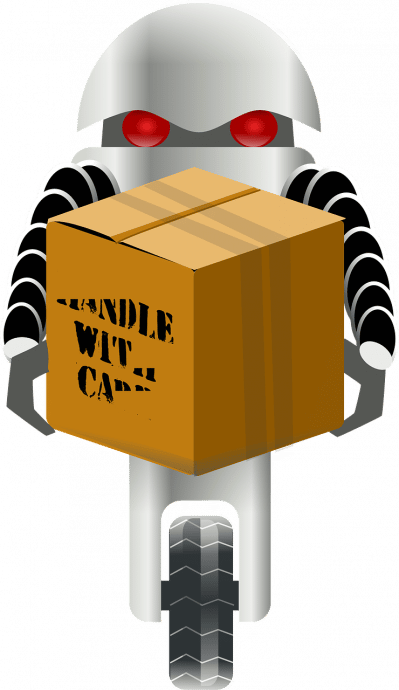Including: Fastest Unloading Robot.
Fastest unloading robot, created by Pickle Robots, ‘Dill’, is a one-armed box-unloading robot capable of unloading up to 1600 boxes per hour. The design is based around a KUKA robotic arm and while shown to operate autonomously, ‘Dill’ is intended to function under human supervision.
Agricultural Robots.
No Human Can Match This High-Speed Box-Unloading Robot Named After a Pickle. Able to move 1,600 boxes per hour using just one arm, Dill relies on humans to keep it operating efficiently.
ProMat, a company called Pickle Robots is announcing Dill, a robot that can unload boxes from the back of a trailer at places like ecommerce fulfillment warehouses at very high speeds. With a peak box unloading rate of 1800 boxes per hour and a payload of up to 25 kg, Dill can substantially outperform even an expert human, and it can keep going pretty much forever as long as you have it plugged into the wall.
Pickle Robots says that Dill’s approach to the box unloading task is unique in a couple of ways. First, it can handle messy trailers filled with a jumble of boxes of different shapes, colors, sizes, and weights. And second, from the get-go it’s intended to work under human supervision, relying on people to step in and handle edge cases.
Source: YouTube
Pickle’s “Dill” robot is based around a Kuka arm with up to 30 kg of payload. It uses two Intel L515s (Lidar-based RGB-D cameras) for box detection. The system is mounted on a wheeled base, and after getting positioned at the back of a trailer by a human operator, it’ll crawl forward by itself as it picks its way into the trailer. We’re told that the rate at which the robot can shift boxes averages 1600 per hour, with a peak speed closer to 1800 boxes per hour. A single human in top form can move about 800 boxes per hour, so Dill is very, very fast. In the video, you can see the robot slow down on some packages, and Pickle CEO Andrew Meyer says that’s because “we probably have a tenuous grasp on that package. As we continue to improve the gripper, we will be able to keep the speed up on more cycles.”
AI enabled smart kitchens
While the video shows Dill operating at speed autonomously, the company says it’s designed to function under human supervision. From the press release: “To maintain these speeds, Dill needs people to supervise the operation and lend an occasional helping hand, stepping in every so often to pick up any dropped packages and handle irregular items.” Typically, Meyer says, that means one person for every five robots depending on the use case. Although if you have only one robot, it’ll still require someone to keep an eye on it. A supervisor is not occupied with the task full-time, to be clear. They can also be doing something else while the robot works—although the longer a human takes to respond to issues the robot may have, the slower its effective speed will be. Typically, the company says, a human will need to help out the robot once every five minutes when it’s doing something particularly complex. But even in situations with lots of hard-to-handle boxes resulting in relatively low efficiency, Meyer says that users can expect speeds exceeding 1000 boxes per hour.
A drone that can dodge anything thrown at it.
From Pickle Robots’ video, it’s fairly obvious that the comparison that Pickle wants you to make is to Boston Dynamics’ Stretch robot, which has a peak box moving rate of 800 boxes per hour. Yes, Pickle’s robot is twice as fast. But it’s also a unitasker, designed to unload boxes from trucks, and that’s it. Focusing on a very specific problem is a good approach for robots, because then you can design a robot that does an excellent job of solving that problem, which is what Pickle has done. Boston Dynamics has chosen a different route with Stretch, which is to build a robot that has the potential to do many other warehouse tasks, although not nearly as optimally.
The other big difference between Boston Dynamics and Pickle is, of course, that Boston Dynamics is focusing on autonomy. Meanwhile, Pickle, Meyer says in a press release, “resisted the fool’s errand of trying to create a system that could work entirely unsupervised.” Personally, I disagree that trying to create a system that could work entirely unsupervised is a fool’s errand. Approaching practical commercial robotics (in any context) from a perspective of requiring complete unsupervised autonomy is generally not practical right now outside of highly structured environments. But many companies do have goals that include unsupervised operation while still acknowledging that occasionally their robots will need a human to step in and help. In fact, these companies are (generally) doing exactly what Pickle is doing in practice: they’re deploying robots with the goal of fully unsupervised autonomy, while keeping humans available as they work their way towards that goal. The difference, perhaps, is philosophical—some companies see unsupervised operation as the future of robotics in these specific contexts, while Pickle does not.
How Robots Are Taking Our Jobs!
These long-tail problems are everywhere in robotics, but again, some people believe that levels of reliability that are usable for unsupervised operation (at least in some specific contexts) are more near-term achievable than others do. In Pickle’s case, emphasizing human supervision means that they may be able to deploy faster and more reliably and at lower cost and with higher performance—we’ll just have to see how long it takes for other companies to come through with robots that are able to do the same tasks without human supervision.
